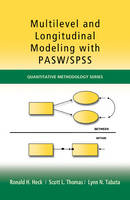
Multilevel and Longitudinal Modeling with IBM SPSS
Routledge Academic (Verlag)
978-1-84872-862-2 (ISBN)
- Titel erscheint in neuer Auflage
- Artikel merken
This is the first book to demonstrate how to use the multilevel and longitudinal modeling techniques available in IBM SPSS Version 18. The authors tap the power of SPSS’s Mixed Models routine to provide an elegant and accessible approach to these models. Readers who have learned statistics using this software will no longer have to adapt to a new program to conduct quality multilevel and longitudinal analyses. Annotated screen shots with all of the key output provide readers with a step-by-step understanding of each technique as they are shown how to navigate through the program. Diagnostic tools, data management issues, and related graphics are introduced throughout. SPSS commands show the flow of the menu structure and how to facilitate model building. Annotated syntax is also available for those who prefer this approach. Most chapters feature an extended example illustrating the logic of model development. These examples show readers the context and rationale of the research questions and the steps around which the analyses are structured. The data used in the text and syntax examples are available at http://www.psypress.com/multilevel-modeling-techniques/ .
The book opens with the conceptual and methodological issues associated with multilevel and longitudinal modeling, followed by a discussion of SPSS data management techniques which facilitate working with multilevel, longitudinal, and/or cross-classified data sets. The next few chapters introduce the basics of multilevel modeling, how to develop a multilevel model, and trouble-shooting techniques for common programming and modeling problems along with potential solutions. Models for investigating individual and organizational change are developed in chapters 5 and 6, followed by models with multivariate outcomes in chapter 7. Chapter 8 illustrates SPSS’s facility for examining models with cross-classified data structures. The book concludes with thoughts about ways to expand on the various multilevel and longitudinal modeling techniques introduced and issues to keep in mind in conducting multilevel analyses.
Ideal as a supplementary text for graduate level courses on multilevel, longitudinal, latent variable modeling, multivariate statistics, and/or advanced quantitative techniques taught in departments of psychology, business, education, health, and sociology, this book’s practical approach will also appeal to researchers in these fields. The book provides an excellent supplement to Heck & Thomas’s An Introduction to Multilevel Modeling Techniques, 2nd Edition; however, it can also be used with any multilevel and/or longitudinal modeling book or as a stand-alone text.
Ronald H. Heck is professor of education at the University of Hawaii Manoa. His areas of interest include organizational theory, leadership, policy, and quantitative research methods. Scott L. Thomas is professor in the School of Educational Studies at Claremont Graduate University. His specialities include sociology of education, policy, and quantitative research methods. Lynn N. Tabata is a Research Consultant and affiliate graduate faculty member at the University of Hawaii.
1. Introduction to Multilevel and Longitudinal Modeling with PASW/SPSS. 2. Preparing and Examining the Data for Multilevel Analyses. 3. Defining a Basic Two-Level Multilevel Regression Model. 4. Three-Level Univariate Regression Models. 5. Examining Individual Change with Repeated Measures Data. 6. Methods for Examining Organizational-Level Change. 7. Multivariate Multilevel Models. 8. Cross-Classified Multilevel Models. 9. Concluding Thoughts. Appendix A: Syntax Statements. Appendix B: Model Comparisons Across Software Applications.
| Reihe/Serie | Quantitative Methodology Series |
|---|---|
| Verlagsort | London |
| Sprache | englisch |
| Maße | 216 x 279 mm |
| Gewicht | 1066 g |
| Themenwelt | Geisteswissenschaften ► Psychologie |
| Sozialwissenschaften ► Pädagogik ► Erwachsenenbildung | |
| ISBN-10 | 1-84872-862-X / 184872862X |
| ISBN-13 | 978-1-84872-862-2 / 9781848728622 |
| Zustand | Neuware |
| Informationen gemäß Produktsicherheitsverordnung (GPSR) | |
| Haben Sie eine Frage zum Produkt? |
aus dem Bereich



